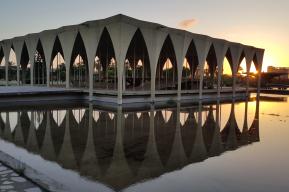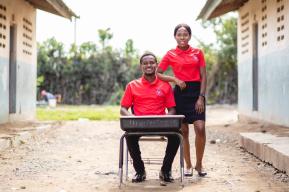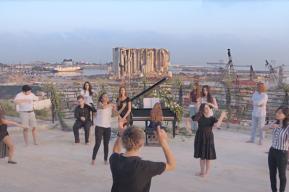观点
卡米尔·阿蒙:“贝鲁特是一座战斗不休的城市,它伤痕累累,疲惫不堪。”

卡米尔·阿蒙(Camille Ammoun)是城市可持续发展专家,致力于增强城市的宜居性和复原力。他同时也是一位作家,希望通过文学探索城市问题的解决之道。他的新作《黎巴嫩十月》(Octobre Liban)带领读者漫步于贝鲁特港口的街巷,如实地还原了这座城市的昔日风貌和跌宕历史。而故事的结尾是2020年8月的爆炸事故,整个首都街区因此面目全非,给居民留下了难以治愈的创伤。
蕾蒂西亚·凯西(Laetitia Kaci) 担任采访
联合国教科文组织
在《黎巴嫩十月》这本书中,您以贝鲁特一条街道上的行人视角,从2019年10月的抗议示威一直写到2020年8月4日发生的爆炸。作为一名作家和城市规划专家,您都看到了什么?
这本书的创作灵感诞生自2019年10月的示威活动。当时我正走在一条街道上,那条街沿港口一路延伸,拥有三个街名:亚美尼亚大街、乌鲁大街和埃米尔-巴希尔大街。关于这座城市的记忆也成为支持我写作这本书的土壤。其实,早在2019年秋天之前,我就想把自己在这座城市中的漫游之旅写成一本书。
贝鲁特是一座不断变化的城市。内战(1975—1990年)结束后,它经历了漫长的重建过程,在小商铺和手工业者的推动下,各条街区有条不紊地恢复了经济活力。21世纪的头10年中,杰美扎区和马尔·米哈伊尔区先后发展成为贝鲁特夜生活的中心,为不拘一格的艺术创作提供了源泉,而布尔吉·哈姆穆德区则始终是城市的核心经济地带。
所有的沿街区域都体现出城市肌理的自发性重组,只有一处是例外——历史悠久的市中心。重建这里的是一家私营房地产公司,由此可见,房地产业的资本主义根本无力打造出一座城市。叙述者的最后一段行程来到了市中心,这里与城市的其他部分完全脱节。但当2019年10月居民占据市中心举行抗议活动时,这一带却成为活跃一时的革命心脏。
我透过十月示威游行讲述这个漫游故事,同时忽然发现了一个新的视角。从市郊的布尔吉·哈姆穆德垃圾场,到高踞坎塔里山顶的政府大楼,两处相距不过四千米。然而,这个距离足以体现整座城市悲惨的本质,也足以让人们看清这个国家如何像梦游者一样,一步步走向毁灭。
贝鲁特河汇集了城市废水,最终流入地中海;中东地区最古老的酿酒厂,黎凡特大酒厂被一家房地产开发商拆毁;马尔·米哈伊尔车站遭遇冷落,周边道路却拥挤不堪;当然,还有贝鲁特港的惨剧。种种迹象表明,罪恶正在不断侵蚀这座城市。
这个故事的主角不是叙述者,而是他走过的那条街。所有人都震惊不已,有人难以置信自己幸存于难,有人哀恸,有人悲伤,有人愤怒,为了这一切,我必须写下这写文字。因为在2020年8月4日下午6时零7分,故事的主角就死在那条街上,死于那场可怕的爆炸。
贝鲁特有哪些独特之处?
在我看来,贝鲁特并非独一无二。与世界各地的许多城市一样,贝鲁特的显著特点是社区和社会的分裂问题,房地产开发商和腐败现象导致城市肌理四分五裂。这里城市规划混乱、污染情况严重、公共空间匮乏、交通运输效率低下。如果说贝鲁特确实有其独特之处,或许就是它集中了上述所有现象,并且以加强版的形式呈现出来。
居民是怎样重新收复城市的?他们目前的居住情况如何?
在2019年秋季爆发的大规模示威活动中,黎巴嫩人重新占据了部分公共空间,例如贝鲁特烈士广场和Riad El Solh广场。卖咖啡和烤玉米的小贩还有旧书摊纷纷出现在那里。贝鲁特大剧院(“小巨蛋”)等标志性建筑也被占领,随即挪为他用。人们支起帐篷,建起一片名副其实的“城市广场”(开放的公共空间)。对于知识、理解和表达的渴望重新燃起,曾经空空荡荡的市中心重新焕发了生机。
示威者还封锁了全国各地的公路。例如在贾尔迪布,居民们占领了北部的一段高速公路,这是通往首都的一条重要干道。封锁行动深受诟病,一些人认为,这些做法是黎巴嫩经济瘫痪的罪魁祸首。而事实上,除此之外民众无处发泄怒火和失望。他们的所作所为,是为了从无到有创造出曾经严重缺失的城市公共空间。
在公共空间里,人们结成社会纽带,彼此相遇相识。由于房地产开发商正在拆毁城市,这些空间如今越发重要。编织城市肌理的建筑物不断倾塌,取而代之的是高楼大厦和高架停车场。在失去公共空间的城市里,人们不再闲游,也不再漫步——跟随机缘的脚步,邂逅相逢。然而,恰恰是这些不期而遇和信步漫游构成了城市艺术活动和创造力的核心,并赋予城市以灵魂。
贝鲁特市中心已然像陈列馆一般奢华,令人望而却步,而市内的其他地区也随时可能被改造,变得车水马龙、高楼林立。当务之急是采取措施,保护城市的层次划分、历史、文化和生活方式。
贝鲁特近几十年来历经多次危机,但总能复原如初。这种复原力源自何处?它会不会因最近的一次磨难而减弱?
诗人娜迪亚·图埃尼(Nadia Tuéni)曾经写道:“贝鲁特死去一千次,又重生一千次。”她的诗句恰好呼应了一则脍炙人口的传说:“贝鲁特曾经七次被毁,又七次重建。”多年来,我们一直在说黎巴嫩人总能东山再起。但在8月4日的那场浩劫中,这种传说中的复原力荡然无存。贝鲁特一蹶不振,消沉不已。爆炸发生后,社交网络上流传的信息只有短短几个字:“我们的情况很糟!”
8月4日的这场浩劫使贝鲁特传说中的复原力荡然无存
一座有韧性的城市在逆境中仍能延绵不息。此前,贝鲁特似乎总能恢复元气,但代价是那些无法抹除的创伤。贝鲁特如今坚韧不再,这座城市战斗不休、伤痕累累、疲惫不堪。今天的贝鲁特只是从前的影子,是原来那座城市的黯淡投影。市中心的街区在1990年被尽数夷为平地,历史建筑毁于房地产开发商手中,8月4日的爆炸事件又再次将其摧毁。已经失去的,再也无法挽回。
爆炸摧毁了部分市区,留下了哪些最明显的伤痕?
首先,自爆炸发生以来,贝鲁特民众一直饱受创伤之苦。这种创伤或许并非肉眼可见,却能带来巨大影响。共有30万人流离失所,为了栖身不得不投亲靠友。重建贝鲁特,需要漫长的时间。
在物质层面,受损最严重的是具有丰富社会多样性的街区和大量属于贝鲁特建筑遗产的房屋。黎巴嫩工程师和建筑师联合会主席贾德·塔贝特(Jad Tabet)介绍说,有32栋建筑被完全摧毁,另有300多栋面临坍塌的风险。这些建筑物的砂岩墙、拱门、木质框架、屋顶瓦片、外墙木制品和阳台的大理石构件都承受不住爆炸的冲击。
马尔·米哈伊尔区和杰美扎区虽然已发展成为高档住宅区,但由于租金限制,这一带原有的居民并未搬迁,从而保留了丰富的社会多样性。重建工程的关键是保持这些街区的社会肌理、经济活力和创造力。
重建工程的关键是保持历史街区的社会肌理
您对重建有哪些构想?
为了避免重蹈覆辙,保护街区不被开发商所掠夺,我们必须为受爆炸影响地区的重建和恢复工作制定法律框架。同时,必须让居民参与城市治理,将他们的意见、习俗和对城市的看法考虑在内。如果无法以有效、开明和包容的方式进行治理,那么不单是在爆炸中损毁的地带,整座贝鲁特城都将继续走向衰落。
我们有理由满怀希望。纵然贝鲁特遭遇挫折、毁于一旦,但它的活力、文化、创造力、人口和地理条件依然赋予了这座城市非凡的发展潜力,并能激发民众的集体想象力。如今,必须让这种城市潜力充分发挥出来,同时让具有创造力的人掌握决策权。
拓展阅读:
《黎巴嫩:战争之殇》,联合国教科文组织《信使》,2006年12月。
《重塑城市》,联合国教科文组织《信使》,2019年4-6月。
订阅联合国教科文组织《信使》,阅读发人深省的时事文章,数字版免费。
在社交网络上关注联合国教科文组织《信使》:微博、微信公众号“联合国教科文信使”、Twitter、Facebook、Instagram。
Interview by Laetitia Kaci
UNESCO
In Octobre Liban (Lebanese October), you walk along a street in Beirut, beginning with the protests in October 2019 demonstrations and ending with the explosion on 4 August 2020. What did you observe, as a writer and urban planning specialist?
This text was born out of the October 2019 demonstrations, when I was walking along the street that runs along the port, and has three names: Rue d'Arménie, Rue Gouraud, Rue Émir-Bachir. It was also nourished by my memories of the city. In fact, the desire to convert my wanderings into a book predates autumn 2019.
Beirut is a city in motion that slowly rebuilt itself after the civil war (from 1975 to 1990). Its neighbourhoods have gradually and organically regained an economic vitality driven by small shops and craftsmen. In the mid-2000s, the districts of Gemmayzeh, and later, Mar Mikhäel, became the epicentre of Beirut nightlife and the source of unbridled artistic creativity – while Bourj Hammoud remained the economic heart of the city.
This spontaneous recomposition of the urban fabric has occurred in all the neighbourhoods bordering this street. All, except one: the historic city centre. Rebuilt by a private realtor, it illustrates the inability of real estate capitalism to make a city. The last stage of the narrator's wanderings, this city centre is totally disconnected from the rest of the city today. Yet, in October 2019, when the inhabitants took it over with their protests, it became the beating heart of the revolution.
While telling the story of this walk through the prism of the October demonstrations, a new perspective came to me. From the Bourj Hammoud rubbish dump on the outskirts, to the seat of government perched on the Kantari hill, the distance is just over four kilometres. Yet this is enough to measure the tragic nature of the city and the way in which the country, like a sleepwalker, has walked towards its ruin.
The Beirut River, which receives the city's wastewater before discharging it into the Mediterranean, the destruction of the Grande Brasserie du Levant [the Middle East’s oldest brewery] by a real estate developer, the abandoning of the [Mar Mikhäel] railway station when all the surrounding roads are congested, and, of course, the port of Beirut, are all symptoms of the evils eating away at the city.
The main character of this story is not the narrator, but the street he walks along. I had to write this text in spite of the collective astonishment, in spite of the astonishment of having survived, in spite of the mourning, in spite of the sadness, in spite of the anger. I had to write it, because on 4 August 2020 at 6.07 p.m., in that dreadful explosion, on that street, this character dies.
How would you define the uniqueness of the Lebanese capital?
I don't think Beirut is unique. Like many cities in the world, it is marked by community and social divisions, a disintegration of the urban fabric driven by property developers and corruption. It suffers from a lack of urban planning, is polluted, and lacks public spaces and efficient transport. If there is something unique about this city, it is perhaps the fact that it combines all these phenomena and offers an exacerbated version of them.
In what way have the inhabitants reappropriated this city? How do they inhabit it now?
During the mass demonstrations of autumn 2019, the Lebanese reappropriated certain public spaces such as the Martyrs' Square and the Riad El Solh Square in Beirut. Coffee vendors, roasted corn-on-the-cob vendors, second-hand bookstalls, all appeared there. Iconic buildings such as The Egg or Beirut’s Grand Théâtre were occupied, and used differently. Tents were erected, and a veritable agora [a public open space] was created. A thirst for knowledge, understanding and expression was reborn. Life returned to the city’s empty centre.
Roads across the country were also blocked by the demonstrators. In Jal el Dib, for example, a section of the northern highway – a vital artery leading to the capital – was occupied by its inhabitants. These actions were heavily criticized. They were seen by some as the cause of the paralysis of the Lebanese economy. In reality, it was the only way the inhabitants could find to express their anger and frustration. In doing so, they created public spaces ex nihilo [out of nothing] in a city which is cruelly lacking in them.
These are places where social bonds are forged, where people can meet and find each other. They are all the more essential now that property developers are in the process of tearing down the city. The buildings that make up the urban fabric are increasingly giving way to buildings with car parks on stilts. In a city without a ground level, people stop wandering or strolling around – letting chance guide their steps, and making random encounters. It is precisely these encounters and wanderings that form the core of a city's artistic activity and creativity, and give it its soul.
While Beirut's city centre is already a museum-like and unaffordable space, the rest of the city also threatens to become a city of parking lots on stilts. It is urgent that measures be taken to safeguard its urban stratification, its history, culture, and way of life.
Beirut has gone through multiple crises in the past decades, but it has always managed to recover. What explains this resilience? Has it been undermined by this latest ordeal?
“Beirut has died a thousand times and been reborn a thousand times,” writes the poet Nadia Tuéni. Her words echo a popular legend: “Beirut has seven times been destroyed, and seven times rebuilt”. For years, we’ve talked about the Lebanese as always being able to rise again. But the apocalypse of 4 August has overwhelmed this legendary resilience. We are not resilient and we are not all right. That’s what messages exchanged on social networks after the explosion simply stated: “We are not ok!”.
The apocalypse on 4 August has overwhelmed Beirut's legendary resilience
A resilient city succeeds in maintaining its urban continuity in spite of hardships. Until then, Beirut always seemed to recover, but with the price of many scars. It is not a resilient city, it is a city that is fighting, a wounded city, a tired city. And today it is only a shadow of its former self, a shadow of the city it could have been. Entire districts of the city centre were razed to the ground in 1990, historic buildings were destroyed by property developers – and then by the explosion of 4 August. What is lost is lost forever.
What are the most visible scars left by the explosion that destroyed parts of the city?
First of all, there is the trauma that has haunted the people of Beirut since the explosion. It may not be visible, but it is powerful. A total of 300,000 people lost their homes and had to find shelter with relatives. The rebuilding will take time.
On the physical level, the areas that have suffered the most are neighbourhoods with great social diversity, and a large number of buildings belonging to Beirut's architectural heritage. According to Jad Tabet, president of the Lebanese Federation of Engineers and Architects, thirty-two of these buildings are completely destroyed and 300 more are at risk of collapse. Their sandstone walls, arches, wooden frames and tiled roofs, the woodwork on their façades, and the marble on their balconies, did not withstand the impact of the explosion.
In spite of their gentrification, the districts of Mar Mikhäel and Gemmayzeh have retained a high level of social diversity, due to the rent controls that have allowed the original inhabitants to stay there. What is at stake with the reconstruction is maintaining the social fabric of these districts, their economic dynamism and creativity.
What is at stake in the reconstruction is maintaining the social fabric of the historic districts
How do you envisage the reconstruction?
In order to avoid repeating the mistakes of the past and to prevent developers from preying on these neighbourhoods, it is essential to establish a legal framework for the reconstruction and restoration of the areas affected by the explosion. Urban governance must involve the inhabitants, taking into account their opinions, their practices and the way in which they view their city. Without effective, enlightened and inclusive urban governance, the city of Beirut – well beyond the areas damaged by the explosion – will continue its slow decline.
There is reason for hope. In spite of its setbacks, in spite of the destruction, Beirut retains an extraordinary urban potential, thanks to its dynamism, culture, creativity, demography and geography – but also by what it evokes in the collective imagination. Today, this urban potential must be able to express itself fully, and those who bear this creativity must be able to take decisions.







